|
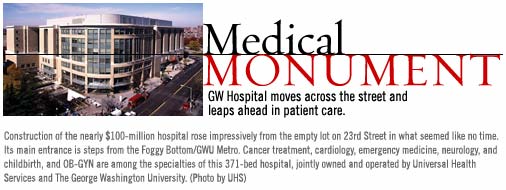

The first new hospital in Washington in more than 25 years opened its doors—our doors—this past August. A striking exterior facility situated across 23rd Street from the old hospital and next to the Foggy Bottom/GWU Metro boasts some of the best that current medical technology has to offer.
Surely the old hospital will be missed. Employees took signs and other small tokens as memorabilia of their time there at a farewell party.
Having opened its doors in 1948, the old hospital served presidents and vice presidents, namely Ronald Reagan in 1981 and more recently, Vice President Dick Cheney. Its staff has managed to save more than a few lives of some of the world’s leading dignitaries—so many, in fact, that the Secret Service helped to design portions of the new building.
No one knows what events will unfold at the new facility. Whatever history brings, the new GW Hospital will be prepared.
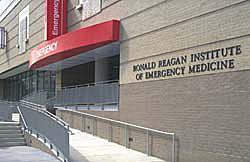 |
The Secret Service helped to design aspects of the Emergency Department, named for its famous patient who received care there in 1981. At 12,000 square feet, this Level 1 trauma center is nearly two-and-a-half times the size of the old space. Four of the treatment rooms were built at double the previous size, to be more suitable for any Washington dignitaries who may need care. The ER serves about 46,000 patients a year.
Universal Health Services photo
|
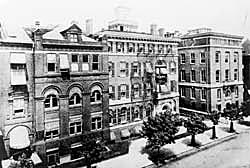 |
One of the earliest teaching hospitals, GW Hospital’s first real home was on H Street. At left is the hospital and at center is its adjoining building constructed in 1902.
University Archives photo
|
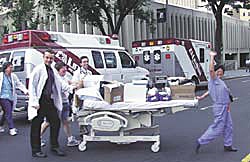 |
For moving day, Aug. 23, the city closed 23rd Street to enable staff to cross the street. A tent placed between the buildings allowed for the private transfer of patients.
UHS
|
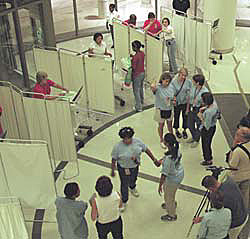 |
Once inside, a team of hospital personnel orchestrated the move, guiding each department safely to its new home.
UHS
|
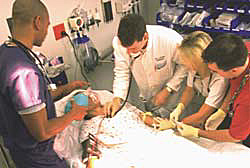 |
The new hospital has 25 beds in the acute care section of the ER. All of the rooms have more space for staff to provide quick response to patients.
UHS
|
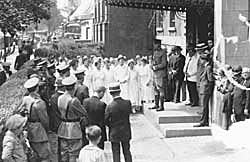 |
At H Street, circa 1917, a ceremony commemorates the formal designation of the hospital as an army general hospital at the beginning of World War I.
University Archives
|
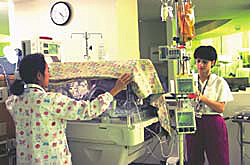 |
The neonatal intensive care unit contains high-tech incubators that mimic life in the womb by keeping noise and light to a minimum. The “baby susans” in the incubators rotate the babies without disrupting their normal sleep patterns. The incubators also have a built-in x-ray unit.
UHS
|
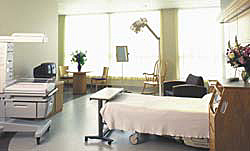 |
The Childbirth Center has new and larger labor, delivery, and recovery suites. With the closure of the Columbia Hospital for Women, GW Hospital staff expects its births will increase dramatically.
UHS
|
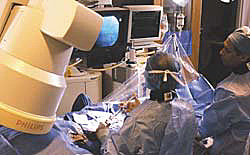 |
Technology is an integral part of the new hospital. At right, the “Integris Allura” x-ray system is a large field-of-view catheterization lab that provides three-dimensional imaging for faster and more precise diagnosis of conditions such as stroke, heart disease, and aneurysms. It provides head-to-toe imaging of carotid and coronary vessels, as most conventional labs do, but it also provides imaging of peripheral vessels, thereby eliminating the need for patients to visit two different labs. The equipment can be used for all types of heart and vascular diagnostic tests, minimally invasive or interventional treatments, and surgery, such as coronary stenting, diagnostic catheterization, balloon angioplasty, and embolization.
UHS
|
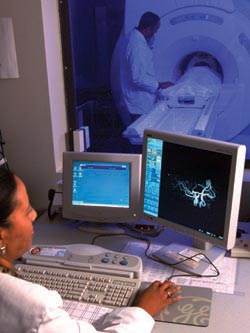 |
The hospital’s new Signa Infinity MRI Imaging System can perform routine magnetic resonance imaging procedures like brain and spine imaging, but it also has the ability to perform advanced applications like vascular and cardiac imaging as well as spectroscopy. The equipment is being fully integrated with the hospital’s picture archiving communications system, which allows filmless imaging and digital image storage.
UHS
|
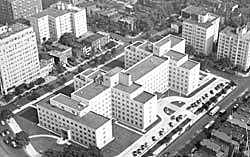 |
The old hospital, in July 1948, was state of the art when it opened. In 1977, a terrace-like addition, the Harry F. Duncan Pavillion, was added above the circular drive, and 23rd Street eventually took over the front-row parking.
University Archives
|
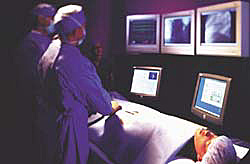 |
GW’s Medical Center occupies the entire top floor, the sixth floor, of the new hospital. In it, students practice procedures on sophisticated “simmaniquins,” computerized patients whose simulated conditions can be manipulated by instructors in an adjoining room. Two full-scale mock operating rooms can be configured as operating room, emergency room, or intensive care unit for realistic surgical training. In mock exam rooms, students learn basic clinical skills and practice their communications in live encounters with actors trained as patients while instructors evaluate them through use of one-way mirrors and video equipment.
UHS
|
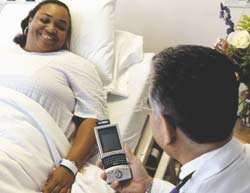 |
Palmtop computers, wireless patient monitors, radio-frequency phones, and wiring for a future paperless system are all features of the new hospital. Doctors can sit bedside and download patient records to their handheld computer. Soon, handhelds and laptops will allow doctors to key in patient orders for lab tests and x-rays, and order medicines from a patient’s bedside. In the radiology department, a new “filmless, paperless” system has been introduced that allows patient records—such as x-rays, MRI scans, ultrasounds, and CT scans—to be digitized for easy transfer. Special encryption codes ensure records remain private inside the hospital’s walls.
UHS
|
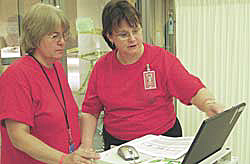 |
Wireless computer stations that can roam from one bedside to the next dot the landscape of the new building. In addition, patient rooms—many of them private—have been constructed in small clusters with a nurse’s station just outside, so that hospital staff is closer at hand than in more traditional hospital layouts.
UHS
|
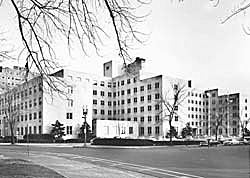 |
A view of the old hospital, in 1954, from Washington Circle, with streetcar tracks in the foreground.
University Archives
|
|